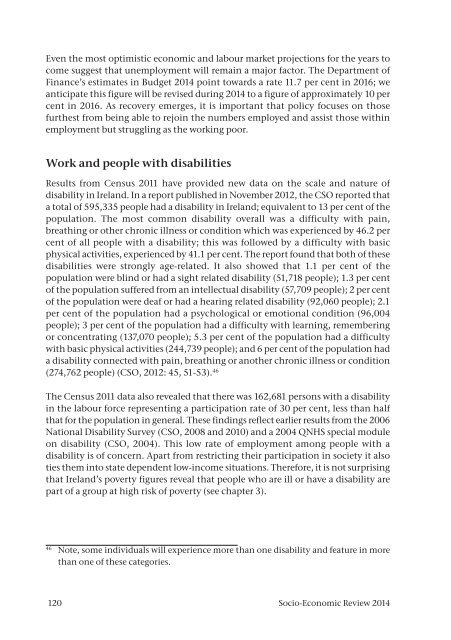2014-04-22 - Socio Economic Review 2014 - Full text and cover - FINAL
2014-04-22 - Socio Economic Review 2014 - Full text and cover - FINAL
2014-04-22 - Socio Economic Review 2014 - Full text and cover - FINAL
Create successful ePaper yourself
Turn your PDF publications into a flip-book with our unique Google optimized e-Paper software.
Even the most optimistic economic <strong>and</strong> labour market projections for the years to<br />
come suggest that unemployment will remain a major factor. The Department of<br />
Finance’s estimates in Budget <strong>2014</strong> point towards a rate 11.7 per cent in 2016; we<br />
anticipate this figure will be revised during <strong>2014</strong> to a figure of approximately 10 per<br />
cent in 2016. As re<strong>cover</strong>y emerges, it is important that policy focuses on those<br />
furthest from being able to rejoin the numbers employed <strong>and</strong> assist those within<br />
employment but struggling as the working poor.<br />
Work <strong>and</strong> people with disabilities<br />
Results from Census 2011 have provided new data on the scale <strong>and</strong> nature of<br />
disability in Irel<strong>and</strong>. In a report published in November 2012, the CSO reported that<br />
a total of 595,335 people had a disability in Irel<strong>and</strong>; equivalent to 13 per cent of the<br />
population. The most common disability overall was a difficulty with pain,<br />
breathing or other chronic illness or condition which was experienced by 46.2 per<br />
cent of all people with a disability; this was followed by a difficulty with basic<br />
physical activities, experienced by 41.1 per cent. The report found that both of these<br />
disabilities were strongly age-related. It also showed that 1.1 per cent of the<br />
population were blind or had a sight related disability (51,718 people); 1.3 per cent<br />
of the population suffered from an intellectual disability (57,709 people); 2 per cent<br />
of the population were deaf or had a hearing related disability (92,060 people); 2.1<br />
per cent of the population had a psychological or emotional condition (96,0<strong>04</strong><br />
people); 3 per cent of the population had a difficulty with learning, remembering<br />
or concentrating (137,070 people); 5.3 per cent of the population had a difficulty<br />
with basic physical activities (244,739 people); <strong>and</strong> 6 per cent of the population had<br />
a disability connected with pain, breathing or another chronic illness or condition<br />
(274,762 people) (CSO, 2012: 45, 51-53). 46<br />
The Census 2011 data also revealed that there was 162,681 persons with a disability<br />
in the labour force representing a participation rate of 30 per cent, less than half<br />
that for the population in general. These findings reflect earlier results from the 2006<br />
National Disability Survey (CSO, 2008 <strong>and</strong> 2010) <strong>and</strong> a 20<strong>04</strong> QNHS special module<br />
on disability (CSO, 20<strong>04</strong>). This low rate of employment among people with a<br />
disability is of concern. Apart from restricting their participation in society it also<br />
ties them into state dependent low-income situations. Therefore, it is not surprising<br />
that Irel<strong>and</strong>’s poverty figures reveal that people who are ill or have a disability are<br />
part of a group at high risk of poverty (see chapter 3).<br />
46<br />
Note, some individuals will experience more than one disability <strong>and</strong> feature in more<br />
than one of these categories.<br />
120 <strong>Socio</strong>-<strong>Economic</strong> <strong>Review</strong> <strong>2014</strong>



